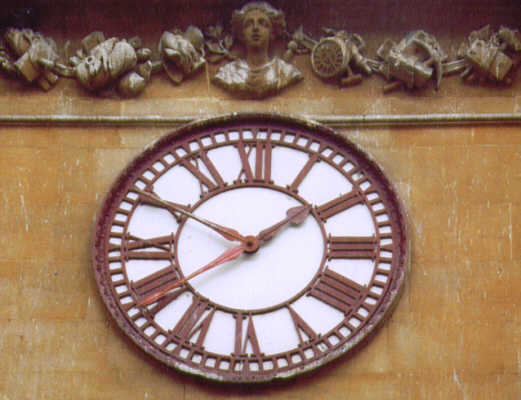
A Walk around the Old City (2)

From Victoria Street to Christmas Steps.
A short walk down St. Shephen's Street brings you to some really fine old buildings and some newspaper history.

The old Bristol Times and Mirror building

The old Bristol Times and Mirror building
The plaque on the building explains why this is an historic building
6. Walking back up to Corn Street we come to the Corn Exchange and its famous Nails.

The Corn Exchange, the clock with two minute hands and the four Nails

The clock with its two minute hands
Before the advent of the railways and telegraphy there was no need for centralised time and so each area of the UK calculated its own local midday. This meant that Bristol, being 2º 35' West of London, was around 11 minutes behind. In November 1840 the Great Western Railway used London time for all its timetables but it wasn't until 1st June 1880 the Statutes (Definition of time) Bill, was read for the first time in the House of Commons, and received the Royal Assent on 2nd August 1880 when all the clocks across the country adopted Greenwich time. the clock in the Corn Exchange facade shows both London and Bristol time.
Bristol has given the world several sayings. "Weakest to the wall" refers to the days when St Mary Redcliffe was without pews and the tired or weaker of the congregation would lean against the walls. "Ship shape and Bristol fashion" refers to the strength and robustness of the Bristol built fleet. Ships built in Bristol had to be tough, to be unloaded they were left till the tide in the harbour ran out and they were beached on the stoney bottom of the River Avon. "Paying on the Nail" originates from the days when deals would be struck and money passed hands on the four bronze nails outside of the Corn Exchange.

A Bristol Nail
Next to the Corn Exchange can be seen the tower of All Saints church.

All Saints tower
The church contains has a stained glass window dedicated to three men, all of whom died but were one time members of the church choir. In March 2002, I received an email from Karen Payne who gave me the story of one of them.
Kenneth Callicott was born in 1922. His mother was my grandmother's elder sister Emily Giles who married Ernest Callicott in 1917. They had three sons Ernest or Victor as he was known, Kenneth Stanley and Richard. They were all from the Moorfield area of Bristol. Kenneth joined the R.A.F. and trained in Texas with No 1 British flying training school. He was a Sergeant Pilot of Spitfires for 155 Squadron. He was shot down once over Pyungang, but managed to get back by riding on a bullock cart for two weeks, he was also helped by the natives. Kenneth fought in the Battle of Britain and escorted Bombers over to France for the D Day landings. Kenneth completed a full tour of operations and was retired. Kenneth then started to test fly the Tempest and Typhoon aircraft but soon became bored. At the veteran age of 22, Kenneth returned to the war, he flew to Burma on a mission. The last words that Kenneth uttered were "I can't see I can't see". The pilot in another Spitfire looked over at Kenneth and reported the plane undamaged. They can only imagine that he had been shot, he went down over Pyungang, Burma in dense jungle and was never found. As young boys both Kenneth and Richard were choirboys at all Saints City and today there is a beautiful stained glass window that reads: 1939-1945 Kenneth Stanley Callicott Chorister All Saints Church Defence medal 1941 Warrent Officer first class Pilot fighter command R.A.F. India Air Crew over Europe and Burma and Stars General Service Medals 1939-1945 killed Pyungang, Burma 12 Sept 1944 aged 22 years. Today the church is now church offices.
The history of Bristol is the story of the people who lived here. My thanks to Karen for giving me permission to reproduce her email for use on my site.
Going down Small Street you can see the old Guild Hall.

The Guild Hall
At the bottom of Small Street you can turn right into a narrow lane. When you come out of the lane you are in Broad Street.
Thanks to Barry Bladon for pointing out that Bristol Time is behind London, not ahead of it.
This page created 15th March 2000, last modified 28th January 2012